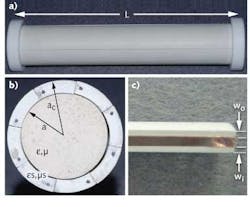
Researchers at the University of Texas at Austin have "cloaked" a macroscopic object in free space from detection in three dimensions at all viewing angles for the first time. The approach works in the microwave region of the electromagnetic spectrum, but is in principle applicable to much shorter wavelengths. Work on metamaterials for cloaking applications has been going on at a feverish pace in recent years with some successes, each with its own limitations. Very few approaches have worked for more than a single incidence angle and viewing angle.
The demonstration is a long-awaited proof of principle for Andrea Alu, who has been championing the use of plasmonic metamaterials for a number of years. He has been watching with interest what has been going on in the field of "transformation optics" in metamaterials. In this most common cloaking approach, nanoscale structures in manufactured materials carefully guide lightwaves in prescribed ways around an object, coming together on the viewing side of the object as if the object were not there. But he says the approach is fundamentally limited to two dimensions.
"More recently, there has been a lot of work on this 'carpet cloaking,' like hiding a bump on a mirror or reflector, but this is still not really what we’re looking for," he explains. "Our goal for this new paper was to prove that we could build a cloak that can work in 3D."
Rather than simply guiding light and reconstructing an image on different sides of a cloaked object, plasmonic metamaterials aim to effectively "undo" the optical effects of the object—a kind of photonegative wrapped around it. The materials are made of metal and dielectric stacks that absorb incoming light and rechannel it in a different form: Surface plasmons, which are traveling excitations that can move around the object and then exit as light.
Alu and his team aimed to cloak an 18-cm-long cylinder from incoming microwaves in a custom-made jacket of plasmonic metamaterial (see figure). To prove that it worked, they used a microwave horn and imaging detector, which could be moved to a variety of viewing angles both above and below and on either side of the cylinder. The result, Alu says, stands in marked contrast to previous works.
"It's a real object standing in our lab, and it basically disappears," he says. "We proved this theoretically seven years ago, but this month we were able to prove it experimentally in a robust way."
Custom-fit jacket
One notable difference between the plasmonic and more standard transformation optics approaches is that the jacket is a custom fit. A different set of stacks would be needed to hide anything other than the dielectric cylinder they cloaked. And the approach works best only for objects with a size not too much greater than the wavelength of light. However, it puts comparatively few constraints on the materials, or requirements to make precise, nanoscale structures that—for an object the size of the cloaked cylinder—would present significant manufacturing hurdles. For that reason, Alu says that plasmonic materials are a significant, novel way forward. "If I had to bet in five years what kind of cloaking technique might be used for applications for practical purposes, then I would say plasmonic cloaking is a good bet."
Alu says the most straightforward applications of the approach may be in noninvasive sensing or near-field imaging. "Plasmonic cloaking has limits, so I wouldn't try to cloak an airplane or a tank," he says. "But if I know I have a 'hotspot,' I can cloak that part, and that may already help a lot." Harry Potter-style cloaks they are not, but Alu says the current work serves as an indication that plasmonic metamaterials are worth pursuing. "There is still a lot of work to be done," he notes. "Our goal was just to show that this plasmonic technique can reduce scattering from an object in free space."
REFERENCE
1. D. Rainwater et al., New J. Phys., doi:10.1088/1367-2630/14/1/013054 (2012).
D. Jason Palmer | Freelance writer
D. Jason Palmer is a freelance writer based in Florence, Italy.